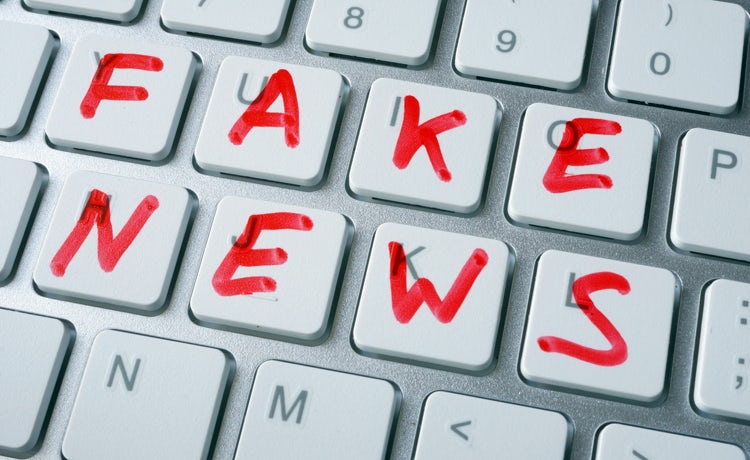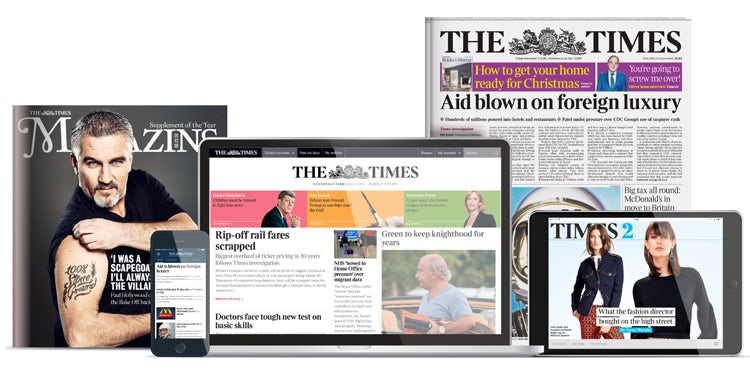The fake news effect: What does it mean for advertisers?
The media industry faces a tough challenge as concerns around fake news rise, meaning advertisers associated with those media outlets could run the risk of being tarred by the same brush.

Consumer confidence in media has taken a significant hit following the rise of ‘fake news’. New research shown exclusively to Marketing Week shows a marked decrease in the trust of mainstream media in the UK as a result of widespread misreporting and false information, which not only damages the media outlets themselves but could have an impact on the brands that choose to advertise with them.
Although the problem is perhaps more rife in the US, UK consumers are already feeling the effects of being subjected to and experiencing fake news in the media they consume.
In the past year, almost half (47%) of consumers have been suspicious that a story they have read may be fake, with 75% of people trusting the media outlet that carried those stories less as a result.
The survey, by Network Research of over 1,000 adults aged 18 to 74, shows trust in information from the media generally has dropped for 32% of people, increasing to 38% for 18- to 34-year-olds.
Three-quarters agree with the statement “you shouldn’t trust everything you read in a news article” and 63% believe the media industry needs more regulation – this decreases slightly to 59% for those aged 55 to 74 but increases to 65% for 35- to 54-year-olds.
Keith Grossman, global chief revenue officer at Bloomberg Media, says: “The consumer expectation is that they are reading ‘real’ news; nobody sets out to read ‘fake’ news. The onus is therefore on [media] brands to have the infrastructure in place – with quality journalists, fact checkers and concrete data, to be able to provide factually correct news to their readers.”
The extent to which news brands promote their reliability is “irrelevant”, Grossman says. “Fake news sites can win a few times before they are recognised for what they are. The best promotion any established brand can do to ensure trust is to always hold the trust of its readers sacred.”
The damage of fake news is that you get valued less in that environment as a brand
Dominic Carter, chief commercial officer at News UK
Attitudes to fake news differ across age groups as 71% of all respondents agree that social media platforms have a responsibility to verify the authenticity of a news story if it is gaining traction or being shared widely, but this increases to 77% for those aged 55 to 74 and decreases to 65% for 18- to 34-year-olds.
Almost half (47%) of all respondents agree traditional news sources, such as newspapers and broadcasters, are more trustworthy and believable than social media sources, and this increases to 68% for those aged 55 to 74.
Dominic Carter, chief commercial officer at News UK, says there is a point to be made about “credible news brands”, the ones “that do care about provenance and accuracy versus a distributor who cares less and therefore isn’t prepared to check [sources], leaving it open for the consumer to go to what could be fake stories”.
He says: “We don’t have a fake news problem, we have an issue with getting advertisers to understand the value of credible trusted news versus an audience, which is playing to the hands of the distributors.”
Building trust among advertisers
While brands, trade bodies and agency bosses wade into the debate surrounding malpractice in digital advertising, publishers are in a good position to showcase credentials and engender trust in cautious advertisers.
The most recent warning around fake news came from world wide web creator Tim Berners-Lee, who named fake news as one of three key challenges in an open letter to mark the 28th anniversary of his invention.
The letter highlights that people find news and information via “a handful of social media sites and search engines” that not only make money from the clicks they receive, but also show content based on algorithms that learn from consumers’ personal data, which “they are constantly harvesting”.
“The net result is that these sites show us content they think we’ll click on – meaning that misinformation, or fake news, which is surprising, shocking or designed to appeal to our biases can spread like wildfire. And through the use of data science and armies of bots, those with bad intentions can game the system to spread misinformation for financial or political gain.”
Berners-Lee also criticised political advertising online and the “suggestions that some political adverts – in the US and around the world – are being used in unethical ways, to point voters to fake news sites, for instance, or to keep others away from the polls”.

He encouraged “exploring alternative revenue models like subscriptions and micropayments” and pushing back “against misinformation by encouraging gatekeepers such as Google and Facebook to continue their efforts to combat the problem, while avoiding the creation of any central bodies to decide what is ‘true’ or not”.
READ MORE: Marketers need to hold Facebook and Google to account
Meanwhile, in March the News Media Association (NMA) called for an “urgent investigation” into Google, Facebook and the digital advertising supply chain to combat fake news – as part of a submission to the Culture, Media and Sport Committee’s existing inquiry.
NMA chairman Ashley Highfield said “the digital supply chain rewards the distributors of content, not the originators” and that the “Government and regulators cannot ignore forever the impact of the Google-Facebook duopoly” on the media landscape.
Carter at News UK agrees but says “advertisers do understand and value context and the dangers of not paying attention to that – where if you do appear on a terrorist website or on a fake news site, the damage to your brand is measurable”.
READ MORE: Brand safety online – can it ever be guaranteed?
He says the solution to the growing question around context and worries about sites that carry fake news lies in the relationship brands have with media agencies.
In addition, they also have to challenge social media aggregators and distributors, such as “the likes of YouTube and Facebook, and the credibility of the source [of the material] their ad is being placed on. It is the responsibility of those people to make sure that doesn’t happen, which [is in their] control”.
The NMA said “although audiences in the UK have so far proved more resilient to fake news than those in the US because of the UK’s robust news media sector, the diversion of digital advertising revenues to Google and Facebook away from the content creators could create the conditions for a fake news industry to thrive here”.
Trust in branded content
Separate research from Outbrain, which surveyed 1,042 UK consumers aged 18 and over who consume online content daily, also shows consumers are becoming “more picky” about where they get their news fix.
With regard to reading news, 64% trust traditional publishers, but only 9% trust social media. For financial advice, 43% trust traditional publishers and 16% trust social media. Although consumers may be growing wary of news items in their social feeds, the research shows little effect on consumer trust in other sources that use social media.
For example, 77% of respondents agree that familiar brands are reliable sources of information, and 66% believe content suggested by a premium publisher is reliable. More consumers trust content made by a familiar brand (77%) than content shared by their friends on social media (67%).
But context again is vital. Network Research’s data relating to advertorials shows that 20% of respondents are more likely to trust the brand sponsoring an advertorial – even if they are unfamiliar with the brand – if it is placed in a media outlet they know and trust; 63% give a neutral answer.
However, even if respondents have a favourable opinion of a brand, if an advertorial is placed in a newspaper or medium they do not like or trust, 19% are more likely to lower their trust in that brand.

“Not all content is the same,” says Abby Carvosso, managing director of advertising at Bauer Media. “Not all attention is equal either – if you have a deeper engagement, you are more likely to get a better recall of that brand message. You are more likely to get a deep engagement if it’s written in the tone of the audience or within the context of something important to that audience.”
Carvosso says it “has to be really clear to the consumer” whether the content that publishers create is editorial or sponsored by brands.
“It’s important that anything on our sites is genuine, edited, authentic, curated and clearly labelled,” she says. “We need to make sure we are telling people and giving them that confidence and trust. We have got to have a big voice in this as content creators.”
Changing media consumption in a post-truth world
Despite concerns of the validity and authenticity of content and sources, the data from Network Research shows social media has seen the biggest rise in consumption.
Nearly a quarter (24%) say they have used it more compared to a year ago, increasing to 35% for 18- to 34-year-olds, whereas 8% in total have reduced their use.
Almost a fifth (19%) have increased their use of websites and blogs and 15% now use news aggregator apps such as Google and Apple news more. And nearly a fifth (18%) read newspapers less – this increases to 20% for 18- to 34-year-olds – but 14% in total read newspapers more often, which rises to 20% for 18- to 34-year-olds.
The top five media sources used in the past month are the BBC (80%), Sky News (34%), The Daily Mail and Mail Online (34%), Metro (27%) and news articles published on Facebook (24%).
But the data shows trust in Metro (16%), BuzzFeed (14%) and The Daily Mail and Mail Online (14%) has decreased compared to a year ago.
Trust has increased for The Huffington Post (29%), Sky News (22%), The Guardian (19%) and the BBC (18%). Interestingly, trust has also increased for news articles published through Facebook (31%) and Twitter (39%).
Sue Todd, chief executive of Magnetic, the marketing body for magazines in the UK, says the lack of trust has resulted in more people seeking a reliable source of information, which has been good news for specialist magazines that focus on current affairs.
The latest Audit Bureau of Circulation (ABC) measurement for sales in print, released in February, shows the collective performance of The Spectator, The Week, Private Eye and New Statesman is up 3% on the previous six months. The Week was singled out in particular for having 36 consecutive ABC increases since launch, representing a consistent increase in sales.
Government and regulators cannot ignore forever the impact of the Google-Facebook duopoly.
Ashley Highfield, NMA
Todd says: “All publishers are getting thrown together in the debate about the lack of trust and everyone is challenged. On the passion-led titles, from Time Out to Time Inc, it’s the expertise of the editor and the columnists [that consumers] rely on in their special interest sector.
She believes readers value the expertise, adding consumers “are only going to go to a couple of sources and if it’s in [their] passion area that [brand will be their] go to.”
Statistics from The World Media Group (WMG), made up of media brands including The Washington Post, Bloomberg Media, The Economist, Forbes, Fortune, National Geographic, Newsweek, The New York Times, Time and The Wall Street Journal, claim ads seen on trusted media websites are viewed more attentively by consumers.
The results show that ad campaigns across WMG inventory outperformed benchmarks for the time period measured, with the greatest effect seen for desktop video, where ads achieved viewability rates 21% higher than average against the industry standard for viewability, 50% of an ad had to be viewable for two seconds. On mobile advertising, ads achieved viewability rates 40% higher and engaged consumers for 12% longer, encouraging 43% more interactions.
Matt McAllester, global editor-in-chief of Newsweek, claims the statistics “validate the link between well written, properly researched journalism and the ‘halo effect’ brands experience when their ads are seen alongside it”.
Todd adds that when consumers pay to read news it has an effect on the trust that readers place on the content.
She says: “Digital has driven the perception that if it’s free, it’s not as verifiable. People have a subconscious thought that maybe there’s not as much resource behind it and would sense that magazines are a robust commercial organisation, [so] why would they risk it on something that isn’t true.”
As the many issues surrounding digital advertising show, context is vital for brands. With ads in danger of appearing against fake news, terrorist websites or generally in undesirable places online the media sources that can ensure a credible, authentic, verified and truthful environment have an opportunity to win brand spend and consumer trust.






